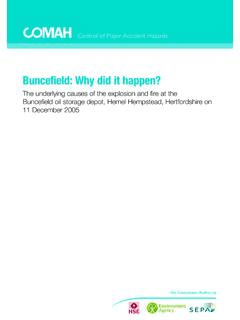Transcription of Problem areas in damages: economic loss ... - 4 New Square
1 1 Problem areas in damages: economic loss, remoteness and betterment Helen Evans and Clare Dixon, 4 New Square economic loss (Helen Evans) What is the general rule, why does it exist and when is it relevant? 1. The starting point is that generally, defendants are not liable in tort for pure economic loss . The term pure economic loss is used to denote financial loss suffered by a claimant which does not stem from damage to his property. As a consequence, no duty is owed by a defendant who negligently damages property belonging to a third party to a claimant who suffers loss because of a dependence upon that property or its third party owner.
2 Whilst all of these propositions sound simple at first, thorny arguments commonly erupt over: a. The circumstances in which defendants can owe a duty to avoid causing economic loss notwithstanding the general exclusionary rule described above; b. What constitutes a claimant s property for the purpose of avoiding the application of the general exclusionary rule. 2. In order to explore these two issues it is necessary to start with the rationale for the law s approach to economic loss. The reason for treating economic loss differently to physical harm was explained by Lord Oliver in Murphy v Brentwood District Council [1991] 1 AC 398 at paras 487B-C in the following terms: The infliction of physical injury to the person or property of another universally requires to be justified.
3 The causing of economic loss does not. If it is to be categorised as wrongful it is necessary to find some factor beyond the mere occurrence of the loss and the fact that its occurrence could be foreseen. Thus the categorisation of damage as economic serves at least the useful purpose of indicating that something more is required. 3. At para. , Clerk & Lindsell on Torts explain the basis for the exclusionary rule by pointing out that where there is physical damage there tends to be a limit on the type of relationships and the number of potential claimants to a claim. However, the relationships giving rise to economic loss are are primarily human in creation and can form a complex web through which financial losses can ripple out from the one negligent act.
4 In other words, the concern motivating the general rule is a fear of indeterminacy of claims. 2 4. Problems with economic loss tend to arise in the sorts of case under discussion today where losses are caused to claimants as a consequence of fires, explosions, floods or the collapse of buildings. At one extreme, there is no exclusionary rule to assist a defendant if by his negligence he burns down a neighbouring building causing loss of profits to a business that owned that neighbouring building. At the other extreme, there is no rule to assist a claimant who has suffered loss of profits as a result of the electricity being cut off by a contractor drilling through a power cable belonging to a utility company and cutting off the power to thousands of properties.
5 As Lord Denning observed in Spartan Steel & Alloys Ltd v Martin & Co [1972] 3 WLR. 502: if claims for economic loss were permitted for this particular hazard [power cuts], there would be no end of claims. Some might be genuine, but many might be inflated, or even false.. It would be well-nigh impossible to check the claims. 5. The difficult cases are the ones in the middle, where there is room for debate about whether the defendant owed a particular duty to a claimant, or whether the claimant had sufficient rights in property to provide the springboard for a claim for loss of profits. The rules applying to this sort of case is the focus of this part of this paper.
6 (1) In what circumstances does a defendant owe a duty not to cause economic loss or are there any other useful routes around the general exclusionary rule? Assumption of responsibility 6. The most common starting point for a claimant is to reach for the authorities applying Hedley Byrne v Heller & Partners [1964] AC 465. A useful and recent summary of this jurisprudence and the circumstances in which a defendant can be held to owe a duty not to cause economic loss is to be found in Sainsbury s Supermarkets Ltd v Condek Holdings Ltd [2014] EWHC 2016 (TCC)(Stuart-Smith J). The key principles emphasised in that case were: a.
7 The need for an assumption of responsibility, which is not limited merely to statements but which may also apply to an assumption of responsibility for services; b. The fact that the test for whether the defendant has assumed responsibility is an objective one, meaning that the focus is on things said or done by the defendant rather than on his state of mind; c. That reliance by the claimant is a necessary ingredient. 3 7. The courts tend to police carefully the circumstances in which the above tests are met: they have repeatedly emphasised that they will be slow to extend the categories of case in which a duty to protect against pure economic loss arises, and astute to examine whether there has really been a voluntary assumption of responsibility by the defendant in relation to the particular type of damage in issue: see Greenway v Johnson Matthey plc [2016] 1 WLR 4503 at para 47 (referring in turn to Customs & Excise Commissioners v Barclays Bank plc [2007] 1 AC 181).
8 Other routes to liability 8. All is not necessarily lost for a claimant whose property has not been damaged and who is unable to prove an assumption of responsibility. Other routes to liability sometimes relied on include claims framed in nuisance and claims brought under the Latent Damage Act 1996. However, as set out below, these additional causes of action either do little to add to the ability to frame a claim in tort or are so restrictive in their application that they will only assist in extremely limited circumstances. 9. The need to frame a claim in nuisance has lessened since the judgment of the Court of Appeal in Shell UK Ltd v Total UK Ltd [2010] 3 WLR 1192 (to which this note returns later below).
9 In order to bring a claim in nuisance, a claimant has to have a proprietary interest in the land affected. It was clear that a mere beneficial interest would suffice for the purposes of a claim in nuisance long before it became clear that it would or might suffice for a claim framed in negligence. Hence, cases used to be articulated in nuisance but can (since Shell UK) be brought in negligence instead. 10. As to the Latent Damage Act 1996, this is only comes to the assistance of an owner of property whose property was damaged before he acquired it but who was unaware of the damage at the time of acquisition. By reason of s.
10 3 of the 1996 Act, a fresh cause of action accrues to the new owner against the defendant on the date on which he acquires his interest in the property. However, Clerk & Lindsell on Torts points out at para that the 1996 Act will not assist unless a new owner can prove he has suffered damage. Many latent problems discovered by new owners are regarded as defects in the building rather than damage to it, leaving the efficacy of the Act very limited. 4 (2) What is meant by property in the economic loss context? 11. If a claimant cannot found a duty on the part of a defendant to avoid causing him economic loss, his alternative method is to explain why his loss in fact flows from damage to relevant property (rather than being pure economic loss).



